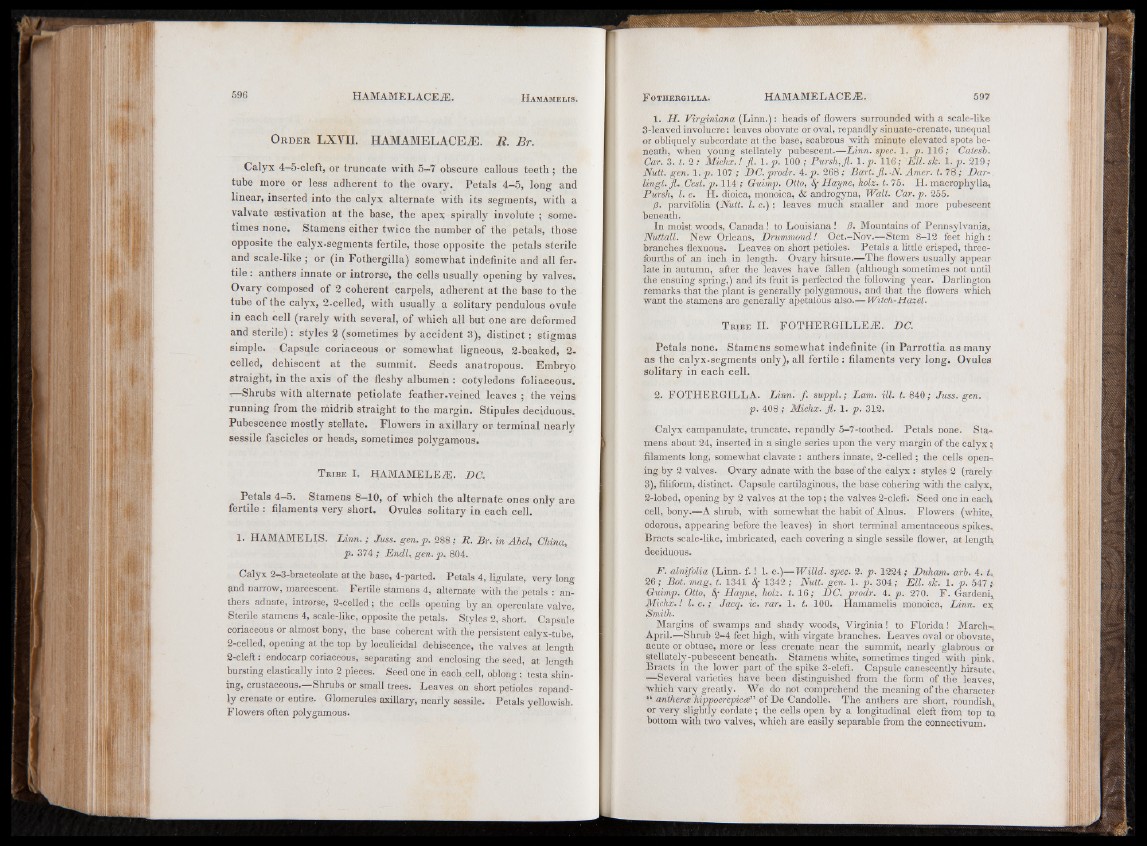
Or d e r LXVII. HAMAMELACEAh R. Br.
Calyx 4-5-cleft, or truncate with 5—7 obscure callous teeth ; the
tube more or less adherent to the ovary. Petals 4-5, long and
linear, inserted into the calyx alternate with its segments, with a
valvate aestivation a t the base, the apex spirally involute ; some-
times none. Stamens either twice the number of the petals, those
opposite the calyx-segments fertile, those opposite the petals sterile
and scale-like ; or (in Fothergilla) somewhat indefinite and all fertile
: anthers innate or introrse, the cells usually opening by valves.
Ovary composed of 2 coherent carpels, adherent a t the base to the
tube o f the calyx, 2-celled, with usually a solitary pendulous ovule
in each cell (rarely with several, o f which all but one are deformed
and sterile) : styles 2 (sometimes by accident 3), distinct 1 stigmas
simple. Capsule coriaceous or somewhat ligneous, 2-beaked, 2-
celled, dehiscent a t the summit. Seeds anatropous. Embryo
straight, in the axis o f the fleshy albumen : cotyledons foliaceous.
i Shruhs with alternate petiolate feather-veined leaves ; the veins
running from the midrib, straight to the margin. Stipules deciduous.
Pubescence mostly stellate. Flowers in axillary or- terminal nearly
sessile fascicles or heads, sometimes polygamous.
T ribe I. HAMAMELEAS. DC,
Petals 4—5. Stamens 8—10, o f which the alternate ones only are
fertile : filaments very short. Ovules solitary in each cell.
1. HAMAMELIS. L in n .; Juss. gen. p. 288; R. Br, in Abel, China,
p. 374 ; Endl, gen. p , 804.
Calyx 2-3-bracteolate at the base, 4-parted. Petals 4, ligulate, very long
and narrow, marcescent. Fertile stamens 4, alternate with the petals : anthers
adnate, introrse, 2icelled; the cells opening by an operculate valve.
Sterile stamens 4, scale-like, opposite the petals. Styles 2, short. Capsule
coriaceous or almost bony, the base coherent with the persistent calyx-tube,
2-celled, opening at the top by loculicidal dehiscepce, the valves at length
2-cleft: endocarp coriaceous, separating and enclosing the seed, at length
bursting elastically into 2 pieces. Seed one in each .cell, oblong : testa shin-
ing, crustaceous. Shrubs or small trees. Leaves, on short petioles repandiy
crenate or entire. Glomerules axillary, nearly sessile. Petals yellowish.
Flowers often polygamous.
1. H. Virginiana (Linn.): heads of flowers surrounded with a scale-like
3-leaved involucre: leaves obovate or oval, repandiy sinuate-crenate, unequal
or obliquely subcordate at the base, scabrous with minute elevated spots beneath,
when young stellately pubescent.— Linn. spec. 1 . p. 116; Catesb.
Car. 3. t. 2 : Michx.! jl. 1. p. 100 ; Pursh,Jl. 1. p. 116; Ell- sk. 1. p. 219 ;
Nutt. gen. 1. p. 107 ; DC. prodr. 4. p. 268 ; Bart. Jl. -N. Amer. t. 78; Dar-
lingt.Jl. Cest. p. 114 ; Guimp. Otto, 8f Hayne, holz. t. 75. H. macrophylla,
Pursh, l. o. H. dioica, monoica, & androgyna, Walt. Car, p. 255.
0. parvifolia (Nutt. 1. c .) ; leaves much smaller and more pubescent
beneath.
In moist woods, Canada ! to Louisiana ! 0. Mountains of Pennsylvania,
Nuttall. New Orleans, Drummond! Oct.-Nov.—Stem 8-12 feet high:
branches flexuous. Leaves on short petioles. Petals a little crisped, three-
fourths of an inch in length. Ovary hirsute.—The flowers usually appear
late in autumn, after the leaves have fallen (although sometimes not until
the ensuing spring,) and its fruit is perfected the following year. Darlington
remarks that the plant is generally polygamous, and that the flowers which
want the stamens are generally apetalous also.— Witch-Hazel.
T ribe II. FOTHERGILLEiE. DC.
Petals none. Stamens somewhat indefinite (in Parrottia as many
as the calyx-segments only), all fe rtile : filaments very long. Ovules
solitary in each cell.
2. FOTHERGILLA. Linn. f . suppl.; Lam. ill. t. 840; Juss. gen.
p. 408; Michx. jl. I. p. 312.
Calyx campanulate, truncate, repandiy 5-7-toothed. Petals none. Stamens
about 24, inserted in a single series upon the very margin of the calyx \
filaments long, somewhat clavate : anthers innate, 2-celled ; the cells opening
by 2 valves. Ovary adnate with the base of the calyx : styles 2 (rarely
3), filiform, distinct. Capsule cartilaginous, the base cohering with the calyx,
2-lobed, opening by 2 valves at the top; the valves 2-cleft. Seed one in each
cell, bony.—A shrub, with somewhat the habit of Alnus. Flowers (white,
odorous, appearing before the leaves) in short terminal amentaceous spikes,
Bracts scale-like, imbricated, each covering a single sessile flower, at length
deciduous.
F. alnifolia (Linn. f . ! 1. c.)— Willd. spec. 2. p. 1224; Duham. arb. 4. t ,
26; Bot. mag, t. 1341 Sf 1342 ; Nutt. gen. 1. p. 304; Ell. sk. 1. p. 547;-
Guimp. Otto, Sf Hayne, holz. t. 16; DC. prodr. 4. p. 270. F . Gardeni,
Michx.! 1. c. ; Jacq. ic. rar. 1. t. 100. Hamamelis monoica, Linn, ex
Smith.
Margins of swamps and shady woods, Virginia! to Florida! March-.
April.—Shrub 2-4 feet high, with virgate branches. Leaves oval or obovate,
acute or obtuse, more or less crepate near the summit, nearly glabrous or
stellately-pubescent beneath. Stamens white, sometimes tinged with pink.
Bracts in the lower part of the spike 3-cleft. Capsule canescently hirsute.
—Several varieties have been distinguished from the form of the leaves,
which vary greatly. We do not comprehend the meaning of the character
,l antheree hippoerepicee" of De Candolle. The anthers are short, roundish,
or very slightly cordate; the cells open by a longitudinal cleft from top to,
bottom with two valves, which are easily separable from the connectivum.